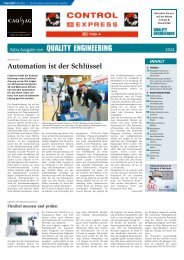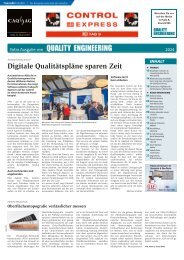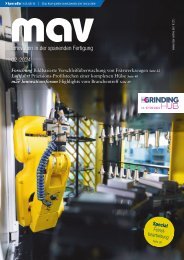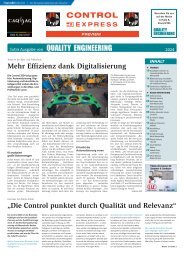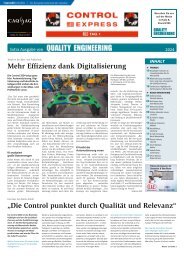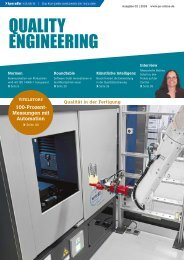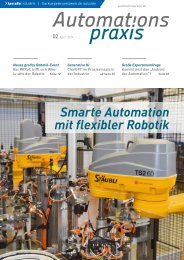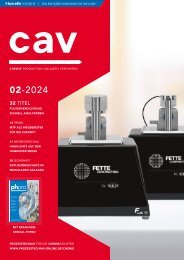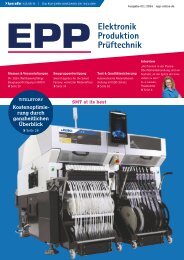cpp – Process technology for the chemical industry 02.2020
The journal cpp - Process technology for the chemical industry reports about processes, plants, apparatus and components for the chemical and pharmaceutical industry. Further topics are IT technologies, industry 4.0, digital production, MSR and automation technology and process analysis technology. The content spectrum is rounded off by explosion protection, plant safety, occupational health and safety, maintenance, site management and energy management.
The journal cpp - Process technology for the chemical industry reports about processes, plants, apparatus and components for the chemical and pharmaceutical industry. Further topics are IT technologies, industry 4.0, digital production, MSR and automation technology and process analysis technology. The content spectrum is rounded off by explosion protection, plant safety, occupational health and safety, maintenance, site management and energy management.
Create successful ePaper yourself
Turn your PDF publications into a flip-book with our unique Google optimized e-Paper software.
Complex network of reactions involved in <strong>the</strong> syn<strong>the</strong>sis of adipate diesters from 1,3-butadiene,<br />
carbon monoxide and alcohol<br />
Comparison of <strong>the</strong> different phosphine ligands with regard to reactivity and selectivity<br />
with a basic pyridyl substituent on <strong>the</strong><br />
phosphorus and a palladium precursor delivers<br />
a yield of ≥95 % and selectivity of<br />
≥97 % in <strong>the</strong> dicarbonylation of 1,3-butadiene<br />
dialkyl adipates.<br />
The right catalyst is key<br />
The difficulty lies in <strong>the</strong> complexity of <strong>the</strong><br />
dicarbonylation reaction, which usually<br />
tends to <strong>for</strong>m numerous by-products. The<br />
simultaneous introduction of two CO<br />
groups presents several challenges in this<br />
catalytic process:<br />
• The simultaneous production of two different<br />
carbonylation reactions on a diene<br />
substrate (no o<strong>the</strong>r research group has<br />
been successful be<strong>for</strong>e)<br />
• The selective <strong>for</strong>mation of <strong>the</strong> linear dicarbonylation<br />
product, although <strong>the</strong> isomerisation<br />
of <strong>the</strong> originally <strong>for</strong>med monocarbonylated<br />
intermediate to <strong>the</strong> terminal<br />
olefin is <strong>the</strong>rmodynamically particularly<br />
unfavorable<br />
• The suppression of o<strong>the</strong>r side reactions<br />
such as telomerisation, hydroalkoxylation<br />
and (co)polymeridation<br />
For <strong>the</strong> development of a suitable catalyst,<br />
palladium-coordinated, base-modified derivatives<br />
of <strong>the</strong> 1,2-bis[(di-tert-butylphosphino)<br />
methyl] benzene ligand (L1, dtbpx),<br />
which is used <strong>for</strong> <strong>the</strong> large-scale production<br />
of methyl methacrylate, were chosen. First<br />
optimisation studies with this ligand<br />
showed low activity but good selectivity.<br />
The incorporation of suitable basic groups<br />
leads to a significant increase in activity.<br />
However, as <strong>the</strong> direct comparison between<br />
L1 and <strong>the</strong> doubly base-modified L4 shows,<br />
this is at <strong>the</strong> expense of selectivity. The solution<br />
was to combine both structural elements.<br />
The specially developed L5 (HeMa-<br />
RaPhos) combines <strong>the</strong> excellent selectivity<br />
of L1 with <strong>the</strong> high reactivity of L4.<br />
Supplementary studies on <strong>the</strong> per<strong>for</strong>mance<br />
and optimisation of <strong>the</strong> catalyst system now<br />
allow <strong>the</strong> direct dual carbonylation of<br />
1,3-butadiene to adipate diesters with high<br />
catalyst conversion rates (>60 000), yields<br />
of up to 95 % and an outstanding selectivity<br />
of over 97 %. The catalyst system can also be<br />
transferred to o<strong>the</strong>r dienes, paving <strong>the</strong> way<br />
<strong>for</strong> a completely new syn<strong>the</strong>sis route <strong>for</strong> <strong>the</strong><br />
production of many fine <strong>chemical</strong>s.<br />
www.<strong>cpp</strong>-net.com<br />
Online search: Evonik<br />
AUTHOR:<br />
PROF. DR.<br />
ROBERT FRANKE<br />
Head of Hydro<strong>for</strong>mylation<br />
Research,<br />
Evonik<br />
<strong>cpp</strong> 02-2020 9



